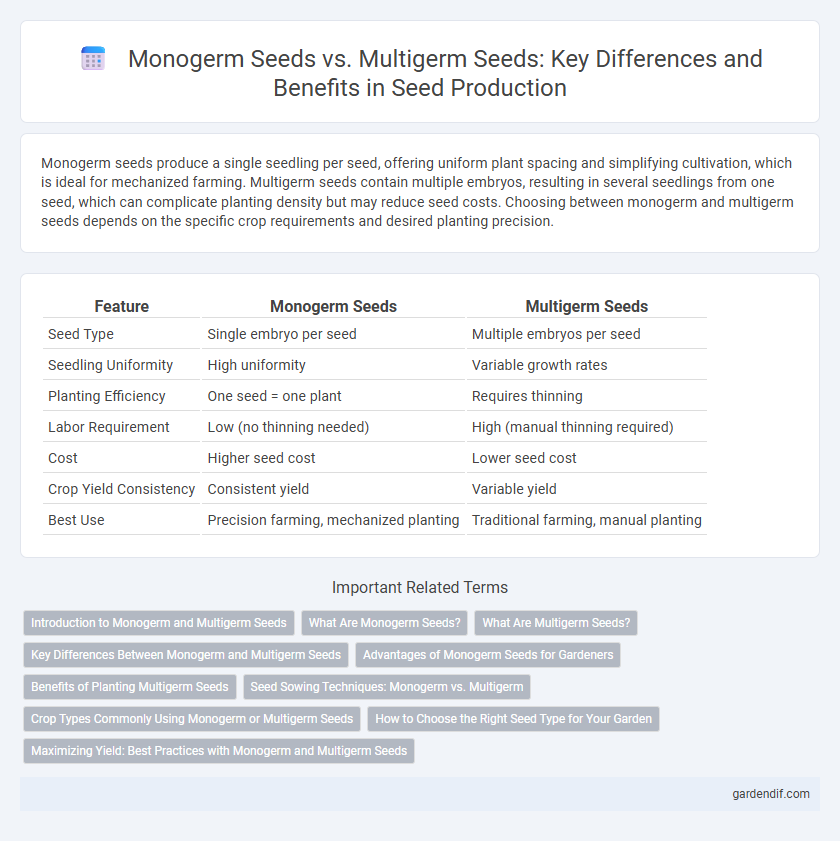
Monogerm seeds vs Multigerm seeds Illustration
Monogerm seeds produce a single seedling per seed, offering uniform plant spacing and simplifying cultivation, which is ideal for mechanized farming. Multigerm seeds contain multiple embryos, resulting in several seedlings from one seed, which can complicate planting density but may reduce seed costs. Choosing between monogerm and multigerm seeds depends on the specific crop requirements and desired planting precision.
Table of Comparison
| Feature | Monogerm Seeds | Multigerm Seeds |
|---|---|---|
| Seed Type | Single embryo per seed | Multiple embryos per seed |
| Seedling Uniformity | High uniformity | Variable growth rates |
| Planting Efficiency | One seed = one plant | Requires thinning |
| Labor Requirement | Low (no thinning needed) | High (manual thinning required) |
| Cost | Higher seed cost | Lower seed cost |
| Crop Yield Consistency | Consistent yield | Variable yield |
| Best Use | Precision farming, mechanized planting | Traditional farming, manual planting |
Introduction to Monogerm and Multigerm Seeds
Monogerm seeds produce a single seedling from one seed, making them ideal for uniform crop stands and mechanized planting systems. Multigerm seeds, by contrast, contain multiple embryos that result in several seedlings per seed, which can lead to denser plant populations and require thinning. Understanding the differences between monogerm and multigerm seeds is crucial for optimizing planting strategies and improving crop management efficiency.
What Are Monogerm Seeds?
Monogerm seeds produce a single seedling from one seed, ensuring uniformity and easier cultivation. These seeds are genetically engineered or selected to develop one main shoot, reducing the need for thinning in crops like sugar beet. Farmers prefer monogerm seeds for efficient planting, consistent crop stands, and higher productivity.
What Are Multigerm Seeds?
Multigerm seeds produce multiple seedlings from a single seed, commonly found in crops like sugar beet and spinach. Each seed contains several embryos, enabling higher plant density but requiring thinning to prevent overcrowding. Multigerm seeds contrast with monogerm seeds, which yield only one seedling per seed, offering uniform plant spacing and reduced labor in cultivation.
Key Differences Between Monogerm and Multigerm Seeds
Monogerm seeds produce a single seedling per seed due to a single embryo, whereas multigerm seeds contain multiple embryos, resulting in several seedlings from one seed. Monogerm seeds simplify planting and reduce thinning requirements, contributing to uniform crop stands, while multigerm seeds often require manual or mechanical thinning to optimize plant spacing. In sugar beet cultivation, monogerm seeds are preferred for mechanized farming, improving efficiency and yield consistency compared to multigerm varieties.
Advantages of Monogerm Seeds for Gardeners
Monogerm seeds produce a single seedling per seed, simplifying transplanting and reducing the need for thinning, which saves gardeners time and effort. These seeds provide uniform plant spacing, promoting healthier growth and higher crop yields by minimizing competition among seedlings. The predictability and ease of handling monogerm seeds make them ideal for efficient garden management and optimized crop production.
Benefits of Planting Multigerm Seeds
Multigerm seeds produce multiple seedlings per seed, increasing plant density and potentially enhancing yield per planting area in crops like sugar beet and spinach. These seeds reduce the need for replanting, lowering labor and seed costs while promoting stronger early crop establishment. Their genetic diversity also improves resilience to pests and environmental stress compared to monogerm seeds.
Seed Sowing Techniques: Monogerm vs. Multigerm
Monogerm seeds produce a single seedling per seed, enabling precise seed sowing techniques that reduce seed density and minimize thinning requirements. Multigerm seeds release multiple seedlings, necessitating higher sowing density and more labor-intensive thinning to prevent overcrowding and ensure optimal plant spacing. Accurate seed sowing practices tailored to monogerm or multigerm characteristics improve crop uniformity and boost yields in sugar beet cultivation.
Crop Types Commonly Using Monogerm or Multigerm Seeds
Monogerm seeds are predominantly used in sugar beet cultivation due to their single-germ trait, which ensures uniform plant spacing and simplifies thinning. Multigerm seeds are commonly found in crops like beetroot and chard, where multiple germinated sprouts per seed increase germination rates and overall yield. Crop choice dictates seed type selection based on planting efficiency and crop management requirements.
How to Choose the Right Seed Type for Your Garden
Choosing between monogerm and multigerm seeds depends on your garden's space and maintenance preferences; monogerm seeds produce single seedlings per seed, simplifying thinning and saving time. Multigerm seeds yield multiple seedlings per seed, which can be ideal for dense planting but require more thinning to prevent overcrowding. Assess your desired plant density and cultivation effort to select the optimal seed type for efficient garden management and maximum crop yield.
Maximizing Yield: Best Practices with Monogerm and Multigerm Seeds
Monogerm seeds produce uniform, single seedlings per seed, enabling precise plant spacing that maximizes yield efficiency in crops like sugar beet. Multigerm seeds yield multiple seedlings per seed, requiring thinning to reduce competition but offering cost-effectiveness for large-scale planting. Optimizing yield involves selecting monogerm seeds for uniformity and labor savings or multigerm seeds when budget constraints favor higher seed densities and thinning practices.
Monogerm seeds vs Multigerm seeds Infographic

 gardendif.com
gardendif.com